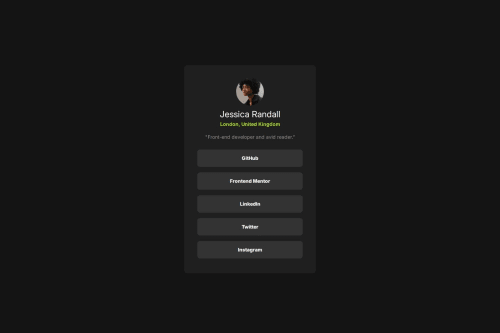Social Links Profile Card

Solution retrospective
I didn't know I could turn a P tag into a container itself to be able to center the text with flexbox. Making the process easier by separating the card into 3 parts. The picture with the name and location, the little quote, and a section for all the "buttons" to go into. That made it easier to separate them and get the spacing right and independent from the other sections. Also, takin advice someone gave me from my last project to make it more responsive to smaller view ports. I took that advice and double checked that everything still looked good on a smaller view port and wasn't cut off.
What challenges did you encounter, and how did you overcome them?At first it was trying to get the text centered in the buttons. If i added padding or margin it made the buttons get wonky so figuring out that I can make a P tag its own container and center it with flexbox like I do everything else was great!
What specific areas of your project would you like help with?I am just trying to get more comfortable with flexbox and what it can do, but it's the easiest way to move things around and get things centered. As I get through the challenges I am trying to remember what worked and what didn't so I am not just doing so much trial and error and hoping to complete the projects quicker. They definitely shouldnt take as long as they do sometimes because there isn't much too them.
Please log in to post a comment
Log in with GitHubCommunity feedback
- @ChimiRinzin-HWR
Great work and great reflections. From as much as I have understood html until now, all of the elements can be turned into a container and can have their properties modified easily just like one another. Except for the time I had difficulties doing the same with <span> elements. If you are trying to use span as a whole single element without another direct element to encase it, keep in mind that you mind face some difficulties and would take time to reach your goals.
Join our Discord community
Join thousands of Frontend Mentor community members taking the challenges, sharing resources, helping each other, and chatting about all things front-end!
Join our Discord